Introduction
Lightning protection of wind mill farm is an integral part, the need for which is determined by the risks when it comes to the personnel safety. They are described in detail in GOST R IEC 62305-2. If the risks are within the acceptable risks for human, then the need for lightning protection of wind power generators is determined by the estimation of the economic costs. The cost of a lightning protection system and material damage from a potential lightning strike are compared. The dimensions of a wind generator are determined by its power. This may be a generator, which is installed on the roof of a single-family house with the capacity of less than 1 kW, and it can be a big generator up to 198 meters high, with the capacity of 7.5 MW, which is enough to provide electricity to a small town. Thus, maintenance and protection methods may differ significantly. However, wind power units (WPU) are high-rise structures, which are often exposed to direct lightning strikes (Fig.1). A lightning strike is a random phenomenon, in contrast to the calculated probabilities based on average data. Therefore, the calculated risk is merely a probabilistic characterization, and accordingly, lightning protection of wind generators is required in most cases!
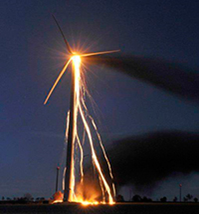
Figure 1. Flash from a direct lightning strike
In the absence of a lightning protection system, a lightning strike can lead to the damage of control systems, electrical systems, blades, and other mechanical parts (Fig.2). Therefore, the design of the wind turbine must be carefully considered, potential risks should be determined and it is necessary to pay special attention to the lightning protection system!
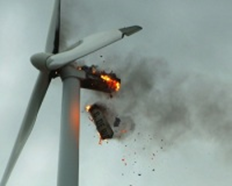
Figure 2. The consequences of a direct lightning strike
1. External lightning protection
1.1. Requirements to external lightning protection system. Reference documents
Lightning protection of wind power generator is performed according to the requirements and recommendations, which are defined by such regulations as:
- GOST R 54418.24-2013;
- IS 153-34.21.122-2003;
- AD 34.21.122-87
According to GOST R 54418.24-2013, p. 6.2 4 levels of lightning protection are organized for wind generators, which are determined based on the area where the wind generator is to be located, and the maximal lightning parameters (charge instant impact, peak current, duration) based on the level of GOST R IEC 62305-1, chart5. It should be noted that the category of lightning protection is set at the design, and accordingly the reliability can exceed the value of category I (0.99). Also, if the wind generator is located in an area with an increased number of upward lightning, it is possible to increase the size requirements to the cross-sections of lightning interception systems. If in the course of the risk analysis, particular requirements for wind generators are not indicated, then all its elements must be protected in accordance with the I level of lightning protection. Thus, the risk analysis may reveal that for some wind generators or wind farms, lightning protection level below I will be economically useful. Also, there can be such circumstances, that for different elements of wing generator units or system, there can be different levels of lightning protection.
NOTE: According to GOST R 54418.24-2013, p.9.2.3, it is not recommended to use external insulated lightning protection for wind generators!
1.2. Lightning rods
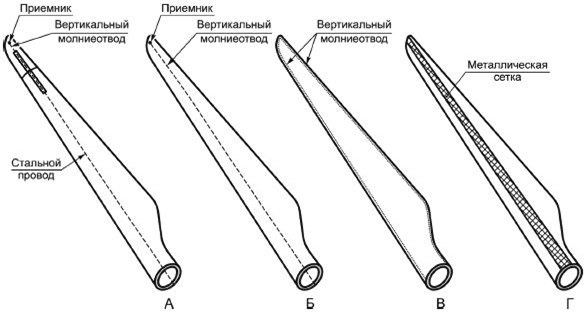
Figure 3. The principles of lightning protection of blades for large wind generators
Приемник – lightning rod
Вертикальный молниеотвод –vertical lightning rod
Стальной провод – steel wire
Металлическая сетка- metal mesh
There are several options for the protection of the wind turbine blades from lightning. Thus, to capture lightning aluminum or copper conductors which can be installed along the entire length of the whole blade, outside or inside it are used. Some designs (Fig.3) they have lightning arresters which are located on the surface around the blade (type B and D), and each of them is connected to conductors which are stretched along its edges. Another way is to use adhesive metal and segment tapes, however, as practice shows, after a few months they are often peeled off, so they are practically not used. The most common solution is to use vertical lightning systems, which are located at the tips of blades (type A and B) and drain current to the butt, and the copper wire along the inner longitudinal member (type B) is used as a vertical lightning rod for the blades with brakes.
Another important part of a wind turbine is a nacelle, the construction of which must necessarily be a part of a lightning protection system. Fiberglass nacelle must have vertical lightning rods, performed in the form of a cage around it. The same mesh could be used as a shield for the protection from magnetic and electric fields from the outside.
1.3. Down conductors
Any lightning protection of a wind generator, as well as any other object, cannot get along without a down conductor. In large wind generators, an empty steel mast-support is used to drain current. It may be called a Faraday cage, because an electromagnetic shield is almost ideal, due to the fact that the electromagnetic field is almost closed at the junction with the nacelle. Therefore, in many cases interior parts of empty masts can be designated by lightning protection level I or II.
Reinforced concrete structures, which are used as down conductors, are used as supports. In this case, the lightning current must go through two - four fittings, which must be connected at the base and every 20 m in height, according to the IS 153-34.21.122-2003, п.3.2.2.3. If the number of fittings is less than the required, it is further possible to arrange artificial down conductors, for example made of copper plated steel or copper wire D8 mm.
2. Internal lightning protection
2.1. Requirements to internal lightning protection system. Reference documents
All wind generator controls elements - electrical and electronic must be protected from surges, potentially arising from:
- outgoing leader currents;
- lightning discharges related to wind turbines;
- indirect lightning strikes;
- electromagnetic pulses arising from switching transients.
Requirements and recommendations of the authorizing documents must be observed:
- GOST R 54418.24-2013;
- GOST P 51992-2011;
- GOST R IEC 60204-1-2007;
- GOST R IEC 61643-12-2011;
- GOST R 52725-2007.
2.2. Selection of surge protection devices
SPDs for wind generators are selected based on the technical characteristics of the electronic / electric equipment. It is possible to identify the main places of installation of surge arresters:
- power generator rotating element;
- converter;
- control board and dispenser;
- communication lines;
- signal lighting and weather sensors;
- measurement and automation systems.
According to GOST R IEC 61643-12-2011, 6.1.4 it is required to install additional protection in areas where there is highly sensitive electronic equipment, in locations with electromagnetic fields inside the unit, as well as where the distance from the power input to the protected equipment is too big (in big wind power plants).
For the protection of transformers and high-voltage system as a whole, high-voltage surge protection devices must be provided, which are better known as "lightning arresters". The need for these devices is determined based on the determination of risks according to GOST R IEC 62305-2, section 7 and annex B). Arresters for the wind turbine must comply with GOST R 52725-2007. They are installed on the transformer inputs (Fig. 4).
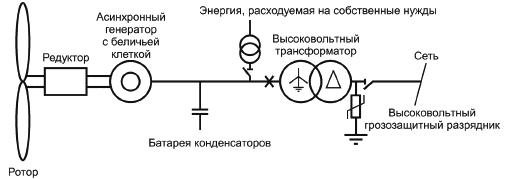
a)
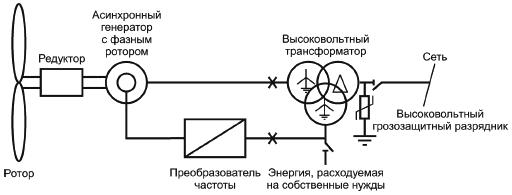
b)
Figure 4. Examples of locating high-voltage arresters in two typical basic electrical circuits of the wind generator (a-AG (asynchronous generator) with the squirrel cage; b - AG with phase rotating device)
редуктор – transforming valve
асинхронный генератор с беличьей клеткой – asynchronous generator with a squirrel cage
высоковольтный трансформатор – high -voltage transformer
сеть - network
энергия, расходуемая на собственные нужды – energy, spent on own needs
ротор - rotor
батарея конденсаторов – capacitor bank
высоковольтный грозозащитный разряздник – high-voltage surge arrester
асинхронный генератор с фазным током – asynchronous generator with the phase current
преобразователь частоты – frequency converter
For a detailed selection of SPD for a wind turbine unit, it is necessary to ask specialists, since it is necessary to take into account all the technical characteristics of the equipment for selecting a particular SPD.
3. Grounding requirements
Both EIC-7, p.1.7.55, and GOST R 54418.24-2013, p. 9.1 recommend the use of a grounding device (GD) simultaneously for lightning protection and grounding. Design requirements for grounding devices are defined by the state standards and rules of electro-technical rules, depending on the voltage of the units. When designing grounding devices for wind turbines, it is necessary to meet the requirements of the acceoted protection level.
Basic requirements to grounding devices, according to GOST R 54418.24-2013, p. 9.1:
- corrosion resistance and mechanical strength;
- prevention of equipment damage;
- ability to withstand electrodynamic and thermal stresses during a short circuit;
- safety regarding step and touch voltages.
Resistance of a grounding device does not affect the effectiveness of the lightning protection system, however, it affects the performance of all kinds of electronic equipment, which is used in measuring systems, automatic control systems, etc. Therefore calculating the grounding system, impedance value of the grounding device should be taken minimal, on the basis of the required values for the equipment used.
There are two main types of electrode groundign devices for wind turbines:
-
Type A - is used for buildings with measuring devices, service areas. For wind generators it is not recommended, composed of horizontal and vertical ground electrodes, are connected to two or more lightning rods.
-
type B - contour (ring) in contact with the ground by not less than 80% of the length. It must have a direct connection with the reinforced concrete base and attached to the mast of the wind turbine.
Vertical electrodes can be used to reduce resistance of a grounding device of type B. The requirements to the length to these electrodes are indicated in Figure 5.
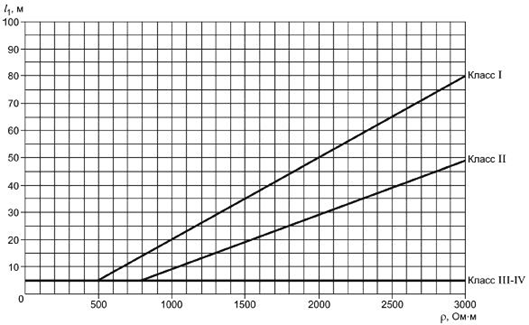
Figure 5. The length of the vertical electrode depending on lightning protection class
4. Conclusion
In conclusion, it can be noted that lightning protection and grounding for wind turbines is a task that requires careful approach and study of all economic and technical issues, such as risks, definition of the lightning protection class for all elements of the wind generator unit, choice of SPD and grounding device.
Wind generator units are often installed in open areas with strong winds, for example in the fields or in the high seas. In such places, wind genertor units are the highest objects, which means that during a thunderstorm a lightning strike is most likely to hit exactly the wind gnerator unit. Consequences of a DLS (direct lightning strike) can be very costly, that is why, the development of lightning protection and grounding is an integral part of the design of wind power stations. Particular attention is paid to grounding devices and SPDs, as these systems are obligatory at any risks! The grounding device must meet the requirements of corrosion resistance, mechanical strength, and also structural requirements according to the class of lightning protection and have the least resistance required for the operation of electronic equipment. SPDs should be selected based on the technical characteristics of the equipment that is used in a particular unit.
Do you need advice on the organization of grounding and lightning protection for your facility? Contact ZANDZ.com Technical Centre !
See also:
- Article by Professor E.M. Bazelyan "Lightning protection of residential and public buildings"
- Useful materials for grounding and lightning protection designers (articles, manuals, guidelines)
- Design of grounding and lightning protection (projects in DWG and PDF formats)
- Webinars for designers and electricians with the leading experts
- Principles of selection of surge arresters
Related Articles:



